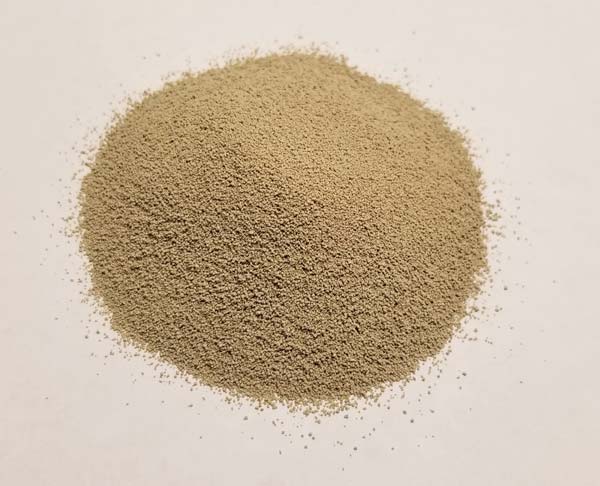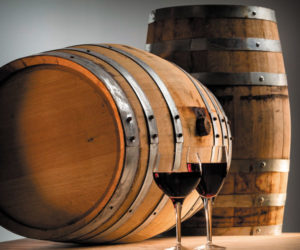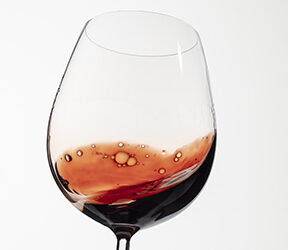Q I followed one of the recipes found on winemakermag.com for grapefruit wine. The wine came out very nice except for one facet — bitterness on the back end. I tried several suggestions like adding a little salt and other stuff. . . but did not like the outcome. Any suggestions on what can be done to finished wine to reduce the bitterness? your help is greatly appreciated.
Zvi Peshkess
Irvine, California
A Ah, the glory and heartbreak that are citrus fruits in winemaking. So many aromas! So many bright flavors! So much acid! And so many potential bitter compounds.
This is where a good fining agent comes in. A fining agent is something that is added to wine that binds with something undesired, then becomes a sediment and is left behind by racking or filtration.
An example of a fining agent is isinglass, a protein isolated from the swim bladders of fish. This is the source of the “Fish Guts in Your Wine?” headline you sometimes see in sensationalist-
leaning wine blogs or consumer pieces. Said pieces are often rooted in click-thrus rather than a true desire to educate wine drinkers. The truth of the matter is that, while good at pulling out excess tannins in wine, isinglass is expensive and, in my experience, rarely used in the wine industry.
Not all fining agents are animal proteins, though isinglass and the ancient “bulls’ blood” seem to get most of the headlines. Bentonite, a naturally occurring mineral clay, is great at adhering to excess proteins in wine and then settling into a compact layer at the bottom of a tank or barrel. Bentonite is very commonly used in most commercial white and rosé wines; its use renders a wine “heat stable,” that is, resistant to forming an unsightly protein haze when the wine is subjected to heat during storage.
Do all wines have fining agents used in them? In my estimation, not by a long shot. Fining agents are expensive and take time to use, not to mention the recommended bench trials to determine the correct dosage. They are a definite intervention in the natural winemaking process and their use needs to be judicious and well thought through. I always say, “Your best fining agent is time.” That and picking your starting material correctly. Fining is usually used to correct faults and flaws or, at best, to nudge a wine in a desired direction.
Bentonite, a naturally occurring mineral clay, is great at adhering to excess proteins in wine and then settling into a compact layer at the bottom of a tank or barrel.
It does appear, however, that you are indeed in need of using a fining agent to remove some of that residual bitterness common in citrus wines. You’ll have to experiment to find the correct fining agent or mix of them. You might want to peruse lists of fining agents sold by various wine supply companies like Laffort, Scott Labs, Enartis, or AEB. They’ve got everything from simple one-ingredient fining agents like the new vegan gelatins to mixes that include things like PVPP (polyvinylpolypyrrolidone), bentonite, and casein. They all have guides about which types of fining agents help bitterness and recommended dosage ranges, but here’s a short list of things I would recommend. Fining agents for bitterness:
- Proteins like gelatin
- Bentonite + casein blends
- PVPP and/or PVPP+protein+ bentonite blends
If you’re a reader of this column you know you can’t get through an issue without me telling everyone that we’ve got to do bench trials to determine how much of any given additive to use . . . and it’s the same case here. Used at higher than needed doses, fining agents can remove too many things from your wine rendering it “stripped” of complexity and sometimes of aromas and color compounds. For this reason, it’s important to only use the minimum effective dose to treat your wine.

When using fining agents, it’s important to follow the manufacturer’s directions and introduce it into your wine according to their suggestions. Usually, fining agents come in liquid or powder form, and you’ll usually dilute the additive in 10 times its weight in water (sometimes the wine itself) and then stir gently but completely into the wine before leaving it to settle. How long does treatment take? Sometimes fining agents seem to work almost instantaneously but it’s always a good idea to take as long as the instructions suggest or, in the absence of directions, for about a week. This is where winemaking in a carboy is a lucky thing; you can visually watch the settling happen over time and will know when you’ve achieved good compaction! Then you typically will “rack the wine off” of the fining agent into a clean, gassed container, leaving the sediment (comprised of the fining agent and the compounds you removed) behind. I wish you luck with hunting for the perfect fining agent magic to combat your bitterness while preserving the charm and freshness of your grapefruit wine.
Q I went to the most recent Winemaker Conference and there was discussion on the benefits of micro-oxygenation during wine storage. I use glass carboys because larger containers are too heavy. I also like to keep the wine on the fine lees. So, I don’t want to rack every three months. I found an O2 wand with a controller that beer brewers use and was wondering if this could be used sparingly in lieu of a larger HDPE vessel, barrel, or more frequent racking. Here is a link to the one I was looking at:
www.anvilbrewing.com/anvil-o2-wand
Zoni Hansen
Manchester, Washington
A A brewer’s O2 wand is an interesting tool and one I’m not familiar with personally, though I think I understand the concept. There isn’t much of a description of the item on the given website, but it looks like it’s a metal wand (which can be placed at the bottom of carboys or kegs) and through which oxygen from a cylinder can be metered. It’s tough to tell what kind of oxygenating stone is at the bottom; if it’s a typical “fish tank bubbler” this is not a proper micro-oxygenation stone and will deliver more of what we would call “macro-aeration” of wine, akin to racking from one container to another.
Micro-oxygenation is something commonly used by people with large tanks. The smaller the container you use in winemaking the greater the ratio of overall lifetime oxygen ingress to wine volume. Barrels (which are naturally porous) and carboys (which sometimes don’t seal completely) typically don’t need any kind of micro-oxygenation work. Racking twice or three times a year using these vessels is sufficient. Once every three months seems excessive to me. Naturally, commercial large-scale winemakers making wine in 50,000-gallon (1,900-hL) stainless steel tanks with small doors and manways need to find ways for oxygen to get into their wines over time. In these cases, micro-oxygenation is a boon and a blessing — and basically a necessity to avoid reductive compounds from rearing their ugly heads.
My main warning with anything related to oxygen in winemaking is to take extreme caution in avoiding overdoing it. Oxygen can be a wine’s best friend but also its worst enemy. During the early stages of winemaking, yeast need a lot of oxygen to grow and ferment correctly. Young, rough tannins and anthocyanins need a certain amount of oxygen to start to condense into larger molecules and help the aging wine smooth out and develop. Too much oxygen, especially after about three months of age, can accelerate the aging process and, if taken too much to the extreme, can cause premature oxidation and can entirely ruin a wine.
Not to leave you hanging (because this is such a large topic it’s impossible to cover everything here), I suggest you undertake some further reading before deciding to open up an oxygen salvo on your small clutch of carboys.
May I recommend this article entitled “Good Oxygen” by Daniel Pambianchi that can be found at: winemakermag.com/article/good-oxygen
Daniel goes into the basics of “macro-” and “micro-”oxygenation in wine. In addition, there’s a great digital audio download available to purchase at winemakermag.com/shop called “Macro-aeration and Micro-oxygenation of Wine”, from the 2009 WineMaker Magazine Conference where Daniel Pambianchi does a deeper dive into a session dealing with these complex and devilishly detailed topics.
My advice at its most basic is to proceed with caution into the wilds of micro-oxygenation only when you’re sure your situation requires it (it’s not a substitute for racking off of solids, for instance) and when you feel comfortable that your tools of choice won’t blast your wine with so much oxygen as to spoil it.
Q I’m making some red wine from local grapes this fall. I had nothing handy to deacidify the must at the crush. Before fermentation, my titratable acidity (TA) was 12 and pH was 3.29. Post-fermentation, my TA was 10 and my pH was 3.38. My paper chromatography showed plenty of malic and tartaric acid, so I’m doing a malolactic fermentation right now to get that TA down and pH up. I’ve read about a product called ACIDEX to reduce TA. I’m also considering doing a cold stabilization to see if I can get some of the tartaric acid to precipitate out and/or using KHCO3 (although I’m not sure if my timing would be correct). If the malolactic fermentation doesn’t reduce the TA enough, what would you suggest?
Jim Skufis
Ann Arbor, Michigan
A In challenging vintages where grapes just don’t get ripe enough, or in areas where summer is cool and the growing season is short, acid reduction methods can really help. The most used acid reduction agents in winemaking are calcium carbonate (CaCO3), potassium carbonate (K2CO3), potassium bicarbonate (KHCO3), or commercial preparations like Acidex or Acidex-K. The carbonate anion reacts with the acids in your juice or wine to form the bicarbonate anion, which reacts with additional acid to form carbonic acid, which then becomes water and CO2 gas.
Because juice and wine generally have an excess of potassium bitartrate (KHT), precipitation of KHT (“wine diamonds” or “tartrate crystals”) will result if potassium carbonate or potassium bicarbonate are used, which is why it’s recommended to follow those additions up with a cold stabilization. This extra step can be a bit annoying and tedious . . . but it is important unless you don’t mind a lot of potassium bitartrate crystals coming out in your wine later. Calcium carbonate may not need this step, but the downside is that solid calcium salts, which can precipitate slowly over time, may also appear in your wine.
I personally tend to use one of the potassium products because the precipitation of any solids tends to be rapid and I always cold stabilize my whites anyway. With reds, I think it’s less of a problem because again, “time is your best fining agent.” With red wine’s long aging trajectory, most of the potassium bitartrate crystals will come out of solution during the aging process, as long as you don’t de-acidify too close to bottling.
If your malolactic fermentation (MLF) doesn’t get your acids into balance as you like, I recommend starting with small amounts of Acidex or one of the potassium-containing products as soon as possible after your MLF is complete. This will give any resulting KHT crystals produced plenty of time to precipitate out. You’ll need to do bench trials of course, starting with small additions first (around 0.25–0.5 g/L, for instance) and working your way up from there. Let the product react with your wine samples at least overnight before you taste and/or do any chemical analysis to assess changes. Always follow the manufacturer’s directions, of course. I also find it helpful to use online deacidification calculators like those found at winebusiness.com (link at the end). With any large wine adjustment, the earlier in a wine’s lifetime it’s made, the better. This will always give your wine its best chance to “bounce back” and integrate those changes more smoothly for long-term aging and character development.
For a wine de-acidification calculator, the following link gives recommended dose rate per desired TA reduction. It also provides answers for many possible different de-acidification agents: www.winebusiness.com/calculator/winemaking/calc/24/
Q I have about 15 gallons (57 L) of freshly crushed Chambourcin grapes and can’t get it to ferment. I did add sulfite for the first time as I’ve read it is helpful in producing cleaner wines. I think I ADDED twice the amount recommended for this size batch. It’s now been 24 hours and no bubbles at all — can this fermentation be saved? My Brix is sitting at 17 without any movement.
Mark Robinson
Funkstown, Maryland
A I think you’ll be OK. Even if you’ve made a double sulfur dioxide addition to your Chambourcin grape must it should eventually still take off, albeit perhaps a bit more slowly than you expected. Let’s say your normal dose was to add 30 ppm to the must and you added 60 ppm instead. Thankfully, during a must or juice addition, a lot of the free antibacterial SO2 gets bound up very quickly and so after a short period of time (like maybe 6 hours or so) won’t even be available anymore to inhibit yeast you might pitch. Also, yeast are less sensitive to sulfur dioxide than bacteria are; this is why a juice or must SO2 addition is mostly done anyway, to inhibit malicious bacteria, not necessarily to “kill” any yeast brought in from the vineyard.
If this is your situation, I’d say to wait at least 6 hours to pitch your yeast to give the excess SO2 a chance to bind up and be less of an issue. It might help to give your must or juice a good stir in order to distribute the sulfur dioxide completely and to encourage binding. In the meantime, you want to give your yeast the happiest possible fermentation conditions, so make sure your juice or must temperature isn’t below 60 °F (16 °C), there isn’t too much acid (keep pH above 3.35), and consider adding a dose of yeast nutrient.






